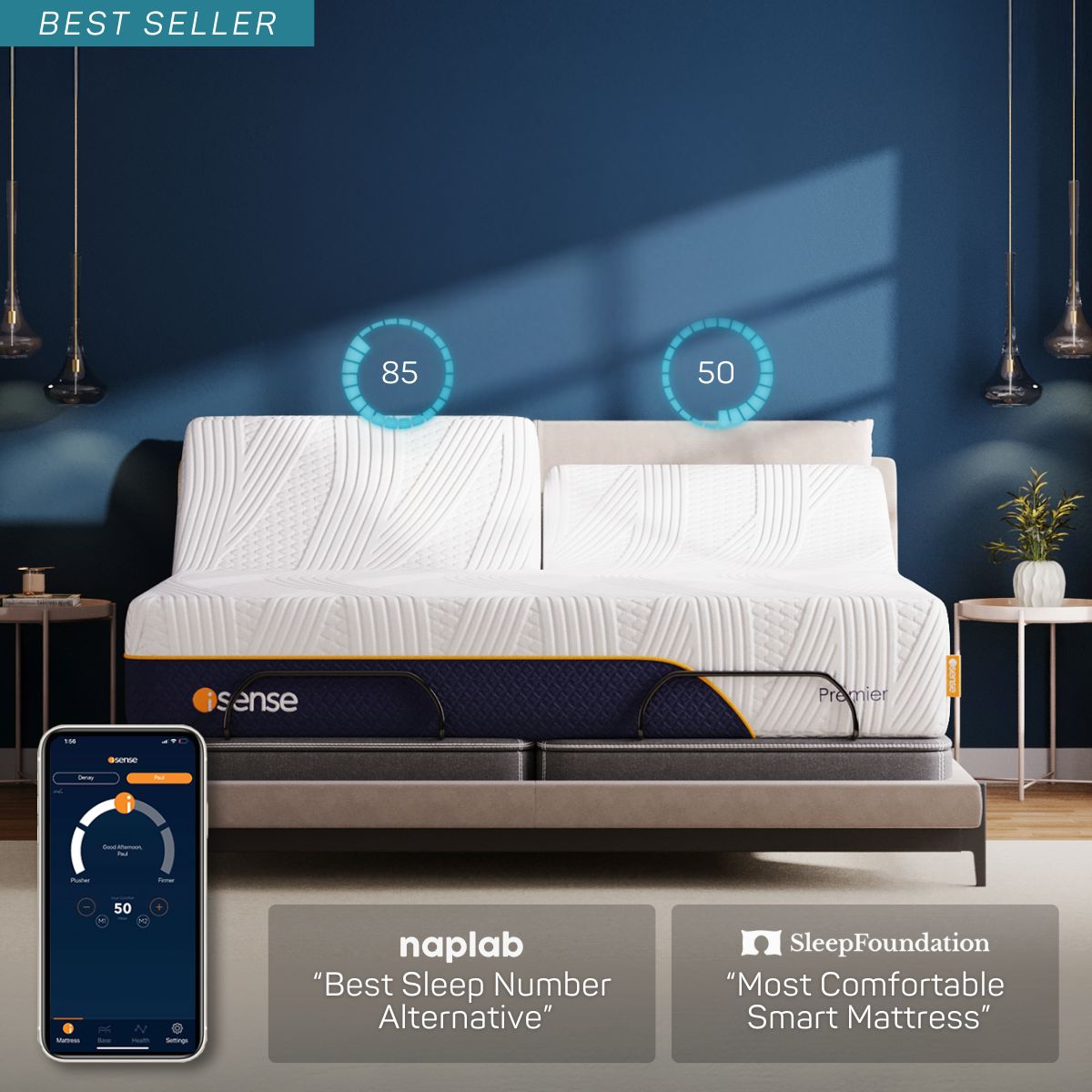
(Seriously, playing with those things is more gratifying than messing with bubble wrap.)
My friends and family roll their eyes at what a total sleep nerd I’ve become, but the truth is even worse: I’ve become a mattress geek, too. Even as I type this, my mind keeps straying to some of the new mattress materials we got in this week. I want to play with them, to pepper one of our resident mattress experts with questions about the support and comfort layers on the mattress he’s building.
Catch that: one of our resident mattress experts.
In a day and age when marketers are taking over the mattress industry, isense Sleep (and our parent company, Advanced Sleep Technologies) is driven by mattress industry veterans. We were founded by the former CEO of A.H. Beard out of Australia. He’s been in the industry for 30 years. Our Operations Director has been in the industry for fifteen years. That man’s ability to build a bed is astounding. I mean, he can just take parts and build a bed that makes you want to nap all day. (Do you have any idea how tempting it is to nap when you work 50 feet from ah-mazingly comfortable beds?)
If you think about it, me becoming a mattress geek was a natural progression. I’ve learned so much about the importance of sleep in the last four months and its integral role as the third pillar of health. (Think about a 3-legged table trying to stand with only two of its legs. That’s diet and exercise without quality sleep.) A pivotal component to getting quality sleep is your mattress—not just any mattress, but the right mattress for you. So, of course, my quest for learning about sleep (and, you know, working at a mattress company) led me to learn about mattresses.

Before my venture into geekdom, I didn’t understand how a mattress could feel so deliciously comfortable in a retail store, only to give me a screaming back days later. But then my boss, mattress guru Paul Longman, said something that blew my mind with its simple brilliance: Everyone talks about pressure points. That’s the comfort layer of a mattress that relieves those; it makes the mattress feel good. But it’s the support components that put your spine in alignment. You need both for a good mattress.
Boom. That’s true mattress wisdom there, folks. I’ve seen a couple of other companies talk about it, but not many. There’s a rumbling in the industry as people start to realize a mattress feeling good isn’t enough. But without the ability to adjust a mattress to your body’s specific makeup, it’s challenging to address the issue.

Why?
Because no two bodies are precisely the same. Finding the right combination of comfort and support to give you the best possible sleep can only be done if you have the ability to sleep on something and then make changes to it based on the feedback your body gives you.
That’s why Paul developed the iSense Sleep Comfort Control™ line of mattresses. Pick the type of mattress surface that works for you (Spring, Foam, or Air), and then adjust the mattress in your own home as your body tells you what it thinks of your choice.
Again, catch that: Paul developed this line of mattresses. He put careful thought and consideration into how to achieve this technology. Where necessary, he partnered with trusted industry partners to bring his vision to life. But the CEO of the company has personally stitched together mattresses to ensure he brought to market something that was not only cutting edge but the highest of quality.
That’s exciting to me—with our mattresses, you’ll get the same quality you’ll find in the premium mattress lines, no longer limited to a compromise of medium firm.
Why do I say that?
Most of the industry will steer you to a medium-firm mattress, hoping to play the law of averages to get you close to something that might be comfortable. Odds are it isn’t, but it’s the best they can do because they don’t have a way to change the mattress for you once you’ve slept on it and realize you’re actually medium firm with a dash of plush.
There are a very small number of mattresses on the market that allow for variable firmness in foam or latex beds. They do so through a process that some feel is a bit cumbersome.
If you’re wondering how you make adjustments to our mattresses, it’s super simple: with the touch of an app (or button, if you prefer a remote!). We even have Comfort Control™ Specialists standing by to help you figure out what your body is telling you. And if you can’t find the right mix by adjusting the mattress with the app, they can help you mix and match comfort components until the bed you bought truly is the right bed for you.
Comfort Control™ Specialist might sound like we just gave a marketing spin to the title for our customer service reps, but it’s so much more than that. This team has immersed themselves in learning about sleep and every aspect of our mattresses so they can understand how to help our customers get the most out of both. That’s a whole post in itself, but if you can’t find one of the Comfort Control™ team, chances are pretty good they’re in the showroom, taking apart or putting together beds to better understand what makes them work.
After four months of cyberstalking competitors, checking out their beds, and beginning to understand the technology they put into them, I truly believe that Paul’s right.
There’s a lot that’s good about what our competitors do, but without the ability to fine-tune your bed, you’re going to fall short of having the right bed for you. Considering the cost of a mattress and the impact it has on your sleep quality, intentionally falling short of something that actually works doesn’t make much sense.
If you check out the pages for our Spring, Foam, and Air mattresses, we dive into what goes into each of our beds there. And, if you are like the vast majority of people and you’re not sure how to decide between spring, foam, or air (or didn’t even know there was a difference), here’s a short run-down.
The Comfort ControlTM Line

Spring
This is the mattress type most people have, know, and love. Still, there’s a wide variety in the types of spring mattresses available, and the quality of comfort and support offered. When designing our spring beds, Paul took the best of the industry to create a masterpiece of support and comfort. I know I’m biased, but this bed is heavenly. It has the responsive feel of a spring bed, but the individually wrapped support coils help reduce motion transfer while providing the strength and support that only American steel can. The NanoCoils I love so much help evenly distribute weight to relieve pressure points and provide dynamic support that moves with you. (Read: it naturally adjusts as you change positions through the night.) When you combine the NanoCoils with Energex memory foam, you get a comfort layer that absolutely beckons you to the bed. Typically a spring bed sleeps cooler and is easier to get in and out of than a memory foam bed.
Most people choose this type of bed for the blend of both comfort and support.

Foam
When you think of foam beds, you probably think of the commercials with a wine glass sitting on the bed as someone drops a bowling ball on it. (I do, at least.) The commercial was intended to illustrate that with memory foam, you don’t have the motion transfer typical in spring beds of the time. (So, your dog jumping on the bed or your partner tossing and turning won’t wake you up.) Memory foam is also a rock star when it comes to relieving pressure. If you toss and turn a lot, memory foam can reduce that. When you lay on one of our foam beds, it’s like being enveloped in a hug of pure comfort.
All of that comfort isn’t great at providing support for your spine, so many foam beds aren’t rock stars at spinal alignment. Memory foam also gets a bad rap when it comes to retaining heat. Many people who bought those early beds complained that they woke up hot because of them.
The industry has come a long way since the wine glass commercials, and memory foam is made differently now. New technologies have developed to address the downsides. Ours is made with a sculpted foam layer to increase airflow and regulate temperature and a high-density polyfoam support core to absorb body weight. The memory foam comfort layer is made with a ThermaPhase gel that sends me into serious dork-out mode. This gel acts as a gatekeeper for temperature extremes—pulling heat away from you if you’re too hot and releasing it if you’re too cold.
People tend to go with this option if they suffer from joint pain or struggle with tossing and turning.

Air
Some people think of air as the mattress you blow up for kids to sleep on when they have friends over or when you go camping. But the original number bed technology was developed using an air chamber. More air = firmer bed. Less air = softer bed. Pretty simple, right? Our mattresses are made differently than the bed you’ve most likely heard of in that arena. Not only do we use a quieter, more efficient pump system, we included additional support components and a notched, wrapped rail system to hold those components together better. (Ever hear of someone complaining because they roll to the center of the bed if one side’s super soft and the other is super firm? Yeah, that won’t happen with ours.) There are other differences, but those are the ones about which you’d probably care most.
People often choose Air if they’re looking for the most significant variation in firmness.
When it comes down to it, it sometimes just boils down to preference. Looking at the features and benefits of different mattress types isn’t quite the same as lying on the bed to see how it feels to you. I seriously go in on my breaks some days to try each bed again because I still haven’t 100% decided which is my favorite (though I’m leaning heavily toward Spring).
So whenever you have a retailer near you, we encourage you to go check them out so you can see and feel the beds for yourself. While you’re there, check out the exclusive VR Experience that takes you inside the mattress to show you how it works!
And yeah, I just went on for three pages about mattresses and loved every minute of it. I need help.






















